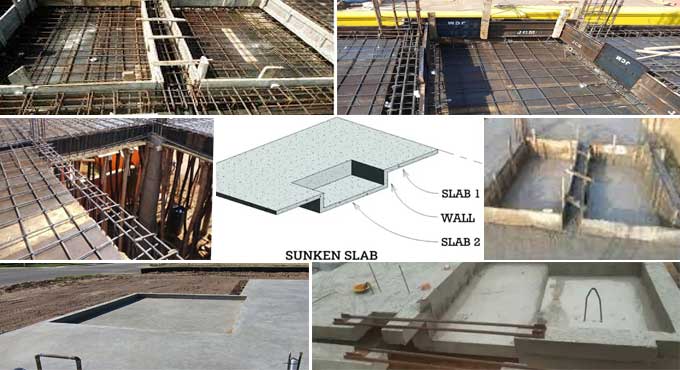NEWS | SOFTWARE | SHEET
Detailed Information about the Sunken Slab
In the context of restrooms, laundry rooms, and other areas where a drainage system is installed, a sunken slab or sink is a type of slab that is constructed below the usual floor level.
To maintain the visual appeal of the room, a sunken slab is provided in order to cover all the pipes below the Standard Floor level in order to preserve the visual appeal of the room. To install pipes and utility ducts, the slab is typically built 20 to 30 cm below the standard floor level.
Broken bricks, sand, coal, or other lightweight material are used to fill up the level gap between the normal floor and sunken slab in order to preserve pipelines and need less maintenance.
It requires extra care to cast the sunken slab since the location where it is offered is susceptible to moisture and water leaks.
Purposes of Sunken Slab
In order to prevent water from splashing into the bathroom and to hide the drainage system's pipes, a slab is placed below the regular floor level to keep the floor level lower than the bathroom level.
It is sometimes necessary to preserve the architectural attractiveness of the structure in order to keep it attractive.
There are different ways to achieve the same effect without utilizing the sunken slab, including raising the floor of the toilet and employing under slung plumbing, each of which has its own advantages and disadvantages.
Application of Sunken Slab
- For restrooms, washrooms, and toilets, it is useless.
- To create a flat ceiling surface on the porch and prevent any downward-caused beam movement.
- To have enough headroom beneath the landing, the staircase's middle landing is ideal.
- When a sanitary system is needed in a unique architectural design, it is employed.
Benefits of Sunken Slab
- It serves no purpose for bathrooms, lavatories, and toilets.
- To make the porch's ceiling flat and stop any beam movement brought on by gravity.
- The middle landing of the staircase is good since it has sufficient headroom underneath it.
- It is used when a sanitary system is required in an original architectural concept.
Drawbacks of Sunken Slab
- The height of the slab is lowered.
- It needs waterproofing and brickbat work, which takes time.
- A trained and knowledgeable worker is required for the building of a sunken structure.
Construction Procedure
- Install the shuttering and centering, but note that the sunken slab's formwork level will now be at the same level as a conventional slab.
- After that, position the reinforcement and bind it to the design.
- Cast the slab once the concrete has dried and become solid and waterproof.
- On the RCC sunken slab, cement and waterproofing material combination should be sprayed.
- Plaster of cement mortar should be covered with a layer, along with a mortar plasticizer.
- Fixing wall and floor tiles with waterproof, non-shrink, waterproofing glue will improve the tile area.
- Sanitary pipes should be joined with a special sealant to prevent water leaks.
Alternative options
Elevated Floor Level: By using this method, the slab for the toilet is built at the standard level of the floor and then the toilet floor is raised above the slab via a step so that the pipes that connect it to the drainage system are hidden.
There are several ways in which the pipes can be hidden and the noise generated during toilet use can be minimized without using a specific plumbing fixture.
Plumbing Under Slung: This technique involves building a toilet slab at the same level as the adjacent slab, and then punching holes or sleeves anywhere that a drainage system pipe has to pass to connect with the toilet slab.
A drainage system is hidden behind a faux ceiling, which is attached directly to the slab of the roof, and the pipes are hidden behind the slab of the roof. It is a common practice for door traps to be fitted with fake ceilings in order to simplify the maintenance process.
To get more details, watch the following video tutorial.
Lecturer: Civil Engineering Mastery
With this system, sunken slab filler material is not necessary, and the drainage system can be easily maintained without causing any damage to the building.
However, this system is more expensive because it needs a specific plumbing fixture to reduce the noise made when using the toilet.


